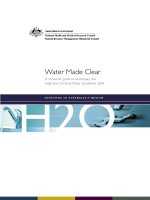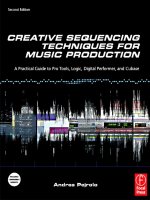A Practical Guide to Particle Counting for Drinking Water Treatment - Chapter 21 pptx
Bạn đang xem bản rút gọn của tài liệu. Xem và tải ngay bản đầy đủ của tài liệu tại đây (95.31 KB, 4 trang )
191
CHAPTER
21
The Complete System
Now that the various features of the different brands of equipment have been
presented, it is time to put them all together and take a brief look at the total system.
The reader should bear in mind the limitations of such an undertaking, as features
change and new models are introduced. If this book is used properly, enough
knowledge should be gained to allow one to evaluate these changes sufficiently. It
would be unfair to the manufacturers and the end user to take the brief comments
made in this chapter as sufficient grounds for making a decision. These comments
are provided to help the reader to see better the “big picture” when undertaking a
thorough evaluation. They are not based on exhaustive empirical studies, or head-
to-head tests on every feature. The manufacturers specification’s and claims have
been taken at face value, and have not been independently verified. The information
presented is based on informed opinion, gathered through much experience with a
broad spectrum of operators and applications, but still subject to the many biases
and flaws of fallen human nature. Caveat Emptor.
A. THE TREATMENT PLANT/APPLICATION
All the equipment reviewed is designed for drinking water treatment applications.
As such, each should perform adequately. Most of the important decisions will have
to be based upon the service record and equipment reliability of each manufacturer,
which will have to be accessed by consulting references. It is important to consult
a sufficient number of references to overcome individual biases and offset the
occasional “black hole” installation that will happen to everyone. Make sure that
proper account is taken for the age of the equipment installed. Many improvements
have been made in the past few years, as the market has matured. Often complaints
stem from frustration with the functionally limited equipment sold in earlier years,
especially before adequate computer interface was provided. Many operators have
never properly learned how to use the equipment, and blame the equipment unfairly.
L1306/frame/pt03 Page 191 Friday, June 23, 2000 2:16 PM
© 2001 by CRC Press LLC
192 A PRACTICAL GUIDE TO PARTICLE COUNTING
Complaints about Hiac Royco early on helped Met One to get a foothold in the
market. Similar complaints are now heard about some of these early Met One
applications. While Hiac Royco made little attempt to improve its products before
selling the line to IBR, Met One has made great strides in the past few years. It is
important to get enough information to take these factors into account. On the other
hand, do not assume that the largest number of installations necessarily means the
best product.
Most of the other considerations will have to do with the ability of the operators
to operate and maintain the system. Some of the systems require a little more effort
to clean and maintain, and a particular style of software presentation may be more
suited to a given set of operators. Although it is becoming less practical to have
each manufacturer set up a demonstration system on site, each will provide demo
software, which should be set up for the operators to try out. Get copies of the
manuals in advance. The “simpler is better” approach is not always true. Assuming
that a computer will make the system too complicated is not usually wise. It is
precisely the ability to see the trended particle counter data that makes the equipment
easier to use. The same goes for auxiliary inputs. Trending particle counts and
turbidity together will be the best way to help the operations staff assimilate the
technology. Do not skimp on training. Initial and follow-up training will make a
great deal of difference.
Most of the turnkey systems are designed to accommodate a large number of
particle counters, so adding units piecemeal or after a plant expansion should not
be a problem. If the turnkey system is to be used for only a couple of years before
a complete SCADA integration is undertaken, the various SCADA integration
options should be studied in detail prior to making the initial purchase. As this is
usually the least-understood aspect of the technology, it is easy to “worry about it
later,” which is unwise. Although the manufacturers typically provide less-than-
optimal support for SCADA integration, it stands to reason that the larger firms
should be able to handle such requests more easily. Met One has certainly had the
most opportunity to have developed expertise in this area, with the largest installed
base of equipment in the water market, as well as experience in other market
segments. The ARTI use of the Modbus RTU protocol is a welcome development.
The Chemtrac protocol was built around the optomux standard in a conscious attempt
to make SCADA integration easier, but most of the standard SCADA optomux
drivers are incomplete and must be modified to accommodate it. Any of the manu-
facturers may have developed an interface for a particular SCADA package, so it
never hurts to check.
B. EQUIPMENT FEATURES
1. Packaging
Packaging is integral to functionality. All the units are designed for use in filter
galleries and other damp environments. It is an advantage to be able to clean the
L1306/frame/pt03 Page 192 Friday, June 23, 2000 2:16 PM
© 2001 by CRC Press LLC
THE COMPLETE SYSTEM 193
flow cell without opening the NEMA enclosure, since water may be spilled into the
enclosure. ARTI and Chemtrac offer the easiest access to the sensor, which sticks
out of the NEMA enclosure, while the others allow access to cleaning without
opening the NEMA enclosure. Clogs or partial obstruction may require opening the
NEMA enclosure of these other units. Met One and IBR have pressure limitations
that could be exceeded if compressed air is used to clear a clogged flow cell.
The removable bottom panel on the Chemtrac counter allows analog I/O signals
to be quickly disconnected and reconnected via plug-in connectors. The IBR and
Met One enclosures leave the power supplies mounted and isolated, but require
individual removal of the analog signals.
2. Sensor Characteristics
All of the units use light-blocking particle sensors. All of them work according
to the same principles outlined in Part I of the book. The largest deviations appear
in the use of less-rugged materials in the Met One sensor, and the nonvolumetric
design of the older Hach/PMS equipment. The former is important as a maintenance
consideration only, in that it must be treated with more care than the others. The
nonvolumetric design of the older Hach sensor could result in the loss of sizing
resolution accuracy. Until tighter standards are developed, this will not be an issue.
3. Counter Electronics
For most online applications, the type of counter electronics is not critical, as
only a few size ranges are ever used. Chemtrac and Met One employ multichannel
analyzers (MCA) type counters, as opposed to the standard comparator types. Met
One uses the MCA card for calibration, which allows the complete system to be
optimized for better performance.
Chemtrac, ARTI, and Met One all offer versatility with regard to analog I/O.
4. Software
A thorough evaluation of the software provided by each manufacturer shows
that less difference exists than one may expect. While certain features may be more
appealing to a given operator, all the manufacturers provide the important features
necessary to a well-run particle counting system.
ARTI, Met One, and Chemtrac offer similar packages, with Aquarius and WQS
being a little more up-to-date with multiple graphing features. The IBR Intellitest
program is not as developed as the others, but is functional, and will likely keep
evolving.
All in all, our recommendation would be that the software offered by all of the
manufacturers is adequate, and should not be the driving factor in the system
selection. All other things being equal, then perhaps the look and feel of a given
program might be a deciding factor.
L1306/frame/pt03 Page 193 Friday, June 23, 2000 2:16 PM
© 2001 by CRC Press LLC
194 A PRACTICAL GUIDE TO PARTICLE COUNTING
5. Experience
Met One is the leader in providing in-house expertise. It is the company with
the most installations, as well as the longest tenure in drinking water applications.
It is larger than the other companies, and should be strengthened by its merger with
Hach. Hach has a tremendous installed base of turbidimeters and other plant instru-
mentation.
Chemtrac is a small company with a good marketing channel but with little
technical expertise. If serious efforts at tightening standards are pursued by the
industry, it is doubtful that Chemtrac will be able to keep up. Equipment must be
improved over time, or it will become dated. The Chemtrac equipment had some
excellent features when it was introduced, but it has never matured as a product.
The IBR equipment has been around since 1988, and it remains to be seen to what
degree it will be improved and advanced.
ARTI has a staff of experienced designers, many having been formerly associated
with Met One. Its alliance with US Filter will give it a good presence in the market.
L1306/frame/pt03 Page 194 Friday, June 23, 2000 2:16 PM
© 2001 by CRC Press LLC






![the game audio tutorial [electronic resource] a practical guide to sound and music for interactive games](https://media.store123doc.com/images/document/14/y/oo/medium_oon1401475551.jpg)


